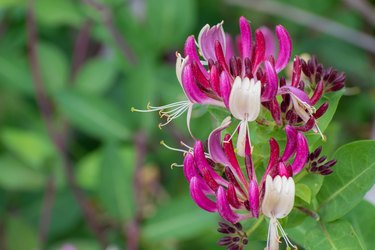
Native climbing vines are a great addition to any Oklahoma garden. In addition to displaying showy flowers and, in some cases, edible fruit, many vining plants native to the state also attract bees, hummingbirds and butterflies. While they can be trained to grow on trellises or other support structures, in many cases, vining plants can also be allowed to sprawl on the ground as ground cover. When choosing native Oklahoma vines, consider the hardiness zone in which you live to make sure the species can survive winters in your area.
Flowering Oklahoma Vines
Video of the Day
Japanese honeysuckle is popular in Oklahoma. However, it is not native, and it can easily become invasive. The yellow honeysuckle (Lonicera flava, USDA plant hardiness zones 5-8), which is native to Oklahoma and the Southeastern United States, is the better choice. This species is cultivated for its fragrant, orange-yellow blooms that appear in May and June. This plant will grow in the shade, but it needs plenty of sun for maximum flower production.
Video of the Day
When it comes to flowering vines, the crossvine (Bignonia capreolata, zones 5-9) is another native option for Oklahoma. This woody vine is prized for its stunning orange flowers. It gets its name because if you slice a stem, the cross-section reveals a shape that resembles the Greek Christian cross. The crossvine is evergreen in the southern portions of its hardiness range, but it develops fall color and drops its leaves in colder climates.
Fruiting Oklahoma Vines
If you are interested in growing grapes in Oklahoma, the fox grape (Vitis vulpina, zones 5-10) is a great native option. The fox grape is a deciduous vine, which means that it loses its leaves in the winter. Also known as a frost grape, the fruit of this variety of grape develops its sweetness only after a frost. However, temperatures below 23 degrees Fahrenheit can injure the plant. The leaves are also edible.
Another option for a fruiting vine native to Oklahoma is the purple passionflower (Passiflora incarnata, zones 5-9). This fruiting vine is also known as the maypop because of the sound its egg-shaped fruit makes when popped. The purple passionflower's fruit ripens in the fall and is often used to make jelly, but it may also be consumed fresh. This plant is also grown for its unusual, striking flowers, which are white and purple.
Other Native Oklahoma Vines
The Virginia creeper (Parthenocissus quinquefolia, zones 3-9) is a deciduous vine native to a large swath of the Southeastern U.S. It grows quickly, reaching lengths of up to 50 feet. It is not grown for its flowers, which are not particularly showy. While it is easy to cultivate, it is important to keep this plant in check, as holdfasts at the ends of its tendrils can damage the exterior of homes.
The lanceleaf smilax (Smilax smallii, zones 6-8) is also native to Oklahoma. It is one of the few smilax species that does not have thorns and does not behave as a weed. They can also handle shade and are a good option for training on a trellis. A lanceleaf smilax plant may reach heights of up to 8 feet.
- Missouri Botanical Garden: Passiflora incarnata
- The Nature Conservancy: Plant This, Not That - A Guide to Native Plants in Oklahoma
- NC State Extension: Vitis vulpina
- NC State Extension: Lonicera flava
- NC State Extension: Bignonia capreolata
- Missouri Botanical Garden: Bignonia capreolata
- Wisconsin Horticulture Division of Extension: Virginia Creeper, Parthenocissus quinquefolia
- Missouri Botanical Garden: Parthenocissus quinquefolia
- The University of Georgia Cooperative Extension: Native Plants for Georgia
- Clemson Cooperative Extension: Smilax (Greenbrier)
- Oklahoma Native Plant Society